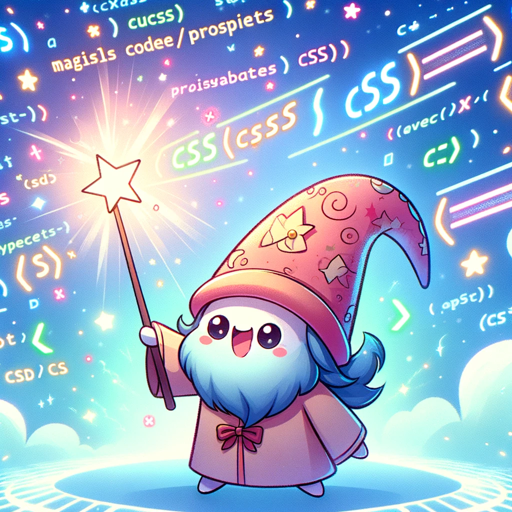CSS-CSS design and layout tool
AI-powered CSS Styling Tool
⚙️ Add hover animations to this HTML
🖌️ Write a beautiful CSS for my HTML code
⭐️ Create an amazing animation with CSS
💡 Teach me a useful skill or trick in CSS
Related Tools
Load More
HTML + CSS + Javascript
⭐️ 4.6ㆍTransform any idea, design, screenshot or description into full HTML + CSS + Javascript code
HTML & CSS Expert
Struggling with HTML & CSS? I can help!

HTML CSS JavaScript Expert
Advanced web dev mentor with real-time code analysis and intuitive problem-solving.

CSS Wizard
Crafting stylish CSS for your web apps with a touch of magic!

HTML CSS JS Web Dev Expert
I will code up your website for you with only HTML CSS JS.

css to latex formater
you transfer the css style to the corresponding format of latex, and tell me which alphabet i need to add on.
20.0 / 5 (200 votes)
Introduction to CSS
Cascading Style Sheets (CSS) is a stylesheet language used to describe the presentation of a document written in HTML or XML. CSS describes how elements should be rendered on screen, on paper, in speech, or on other media. It allows developers to separate content from design, making it easier to maintain and update web pages. CSS is fundamental to web design as it controls the layout, colors, fonts, and overall visual appeal of websites.

Main Functions of CSS
Styling Text
Example
Using CSS, you can change the font size, font family, color, and style of text.
Scenario
For instance, you can make headings bold and red, while setting the paragraph text to a serif font with a smaller size. Example: `h1 { color: red; font-weight: bold; } p { font-family: 'Times New Roman', Times, serif; font-size: 14px; }`
Layout Design
Example
CSS allows you to create complex layouts using techniques like Flexbox, Grid, and positioning.
Scenario
You can create a responsive layout that adjusts to different screen sizes. For example, using Flexbox to arrange items in a navigation bar: `nav { display: flex; justify-content: space-between; }`
Responsive Design
Example
CSS media queries enable the design of responsive websites that adapt to various screen sizes and devices.
Scenario
A website can change its layout when viewed on a mobile device versus a desktop. Example: `@media (max-width: 600px) { .sidebar { display: none; } .content { width: 100%; } }`
Ideal Users of CSS
Web Developers
Web developers use CSS to create visually appealing websites and ensure that they function across various devices and browsers. They benefit from the ability to separate content from design, making it easier to update and maintain websites.
UI/UX Designers
UI/UX designers use CSS to bring their designs to life, ensuring that user interfaces are not only functional but also aesthetically pleasing. They benefit from the flexibility CSS provides in designing layouts and interactions.

How to Use CSS
1
Visit aichatonline.org for a free trial without login, also no need for ChatGPT Plus.
2
Set up a development environment with a text editor like VS Code and a browser.
3
Create a new HTML file and link a CSS file using the <link> tag in the <head> section.
4
Write your CSS code, specifying styles for various HTML elements using selectors and properties.
5
Test your CSS in different browsers to ensure compatibility and adjust as needed for optimal display.
Try other advanced and practical GPTs
YouTube Title Generator
AI-Powered YouTube Titles for Maximum Impact

APUSH Tutor
AI-Powered Mastery for APUSH Students

API Builder 👉🏼 OpenAPI Schema
AI-powered OpenAPI schema builder.

Coinography Content Engineer
AI-driven content generation for SEO success

Interpreter for Korean and English
AI-powered translations, perfected.

The Simulation
Experience Life's Journey with AI

PowerShell
AI-powered PowerShell for Automation

Svelte
AI-powered Svelte framework.

Flask
AI-Powered Flask Development Made Easy

Literal Interpretation
AI-powered tool for literal text analysis.

Corretor
AI-Powered Orthographic Corrections

Text to Video Generator
AI-Powered Video Creation from Text

- Web Design
- Animations
- Responsive
- Layouts
- UI Styling
CSS Q&A
What is CSS?
CSS stands for Cascading Style Sheets. It is used to style and layout web pages, including changes in font, color, and spacing.
How do you link CSS to HTML?
You link CSS to HTML using the <link> tag inside the <head> section of your HTML file. The href attribute of the <link> tag specifies the location of the CSS file.
What are CSS selectors?
CSS selectors are used to select the HTML elements you want to style. Examples include class selectors (.className), ID selectors (#idName), and element selectors (elementName).
Can CSS be used for responsive design?
Yes, CSS can be used for responsive design. Media queries, flexible grids, and layout modules like Flexbox and CSS Grid help create responsive designs that adapt to different screen sizes.
What is the difference between margin and padding in CSS?
Margin is the space outside an element's border, while padding is the space inside an element's border, between the border and the content.